This blackcurrant jam recipe packs a load of nutrients I bet you never even realized! Blackcurrants are an incredible super fruit, but sadly, in the US they’re almost unheard of.
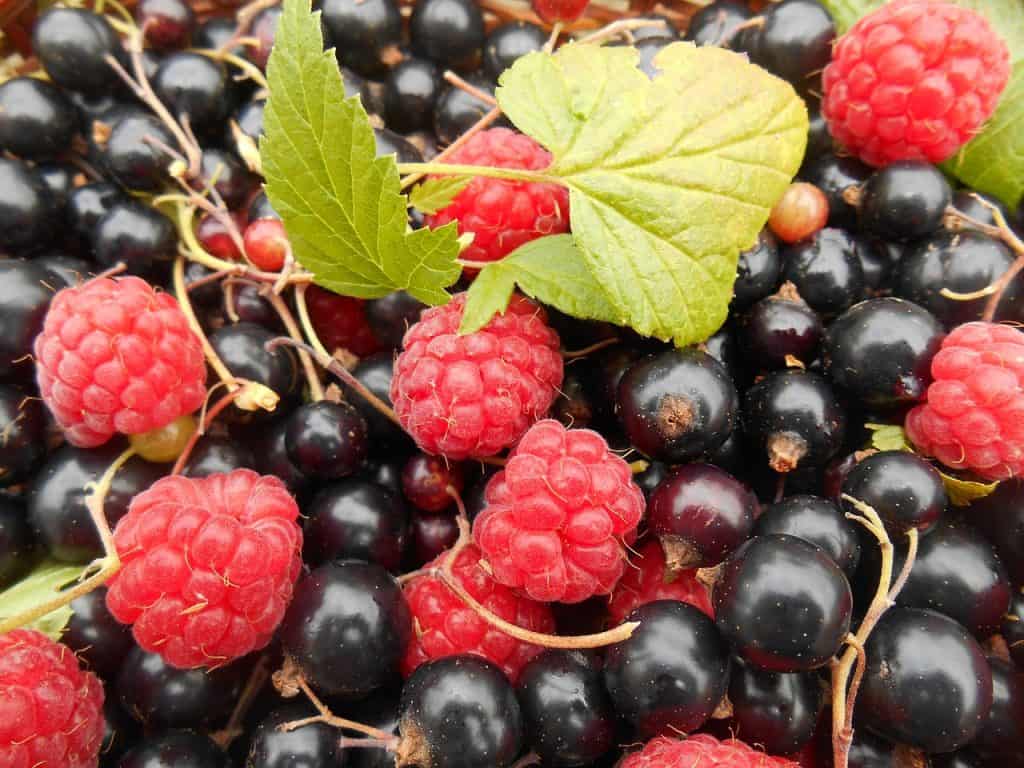
The confusion that exists between blackcurrants and currants is incredible. Actually, it’s not even confusion, just misinformation, but it’s causing Americans miss out on a tremendously nutritious super fruit.
Let me begin by telling you that blackcurrants need no introduction in the UK. I grew up thinking that everyone knew what blackcurrants were. The flavor was (and still is) one of my very favorites. In Britain, everyone eats blackcurrant jam, and fights over the blackcurrant flavored fruit pastilles and fruit gums.
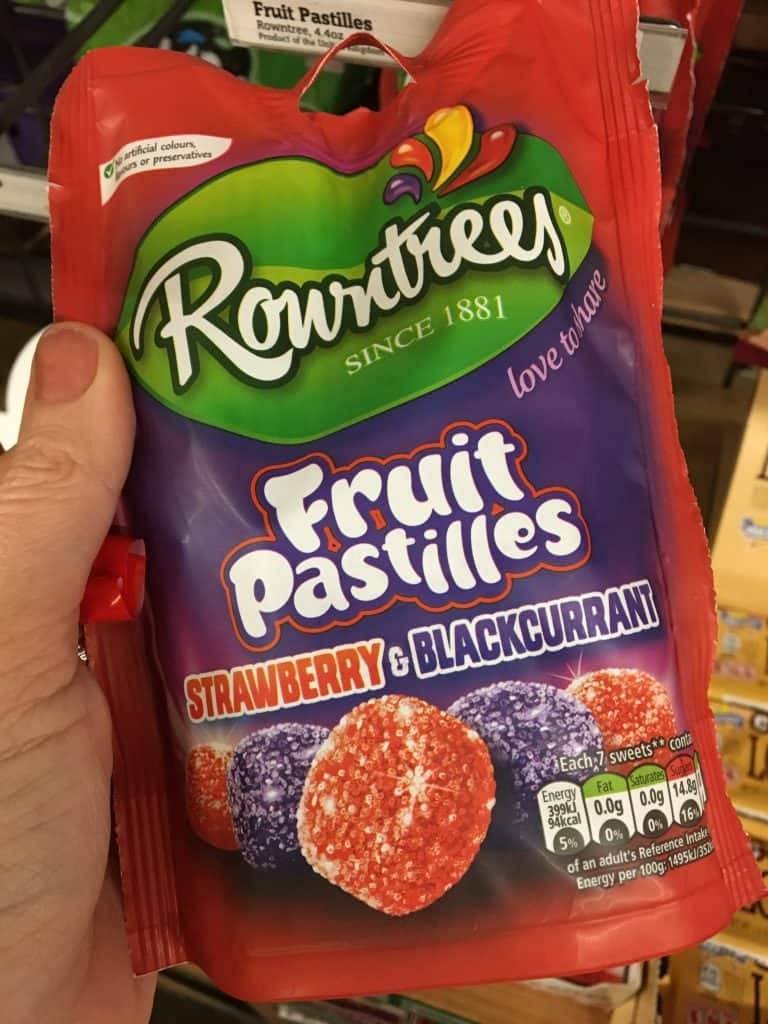
One of the most popular drinks in the UK is called Ribena. It’s made from blackcurrants, and in fact, almost all blackcurrants grown in the UK are used to make this beverage.
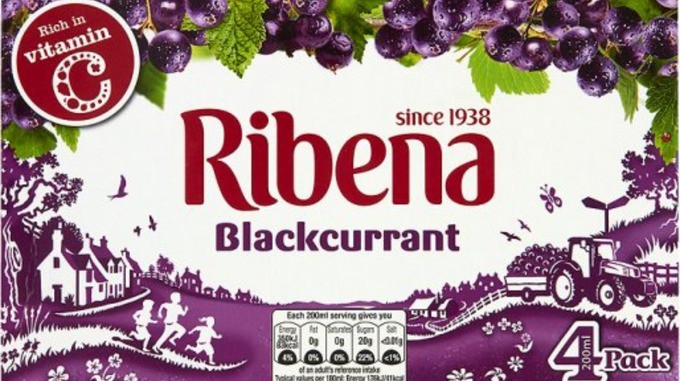
Yes, blackcurrants are a big thing across the pond, so why are they virtually unknown here in the US? Is it the same reason why black pudding isn’t popular? Not exactly.
The Blackcurrant Ban
It’s rather a long story, but I first learned about the ban on black currants on a box of black currant juice drink that Trader Joe’s carried for a short time.
Apparently, some trees were dying on the east coast and somehow the disease was attributed to blackcurrant bushes, so they were obliterated and banned until 1966 (I remember the year because it’s when I was born). However, it was then left up to the individual states. In 2003 ban on blackcurrants was lifted in New York.
Blackcurrants vs Currants
Now, many of you may be familiar with Zante currants (or Corinthian raisins), which are essentially tiny raisins, right? They are called “currants”, but this is a misnomer as they are dried grapes!
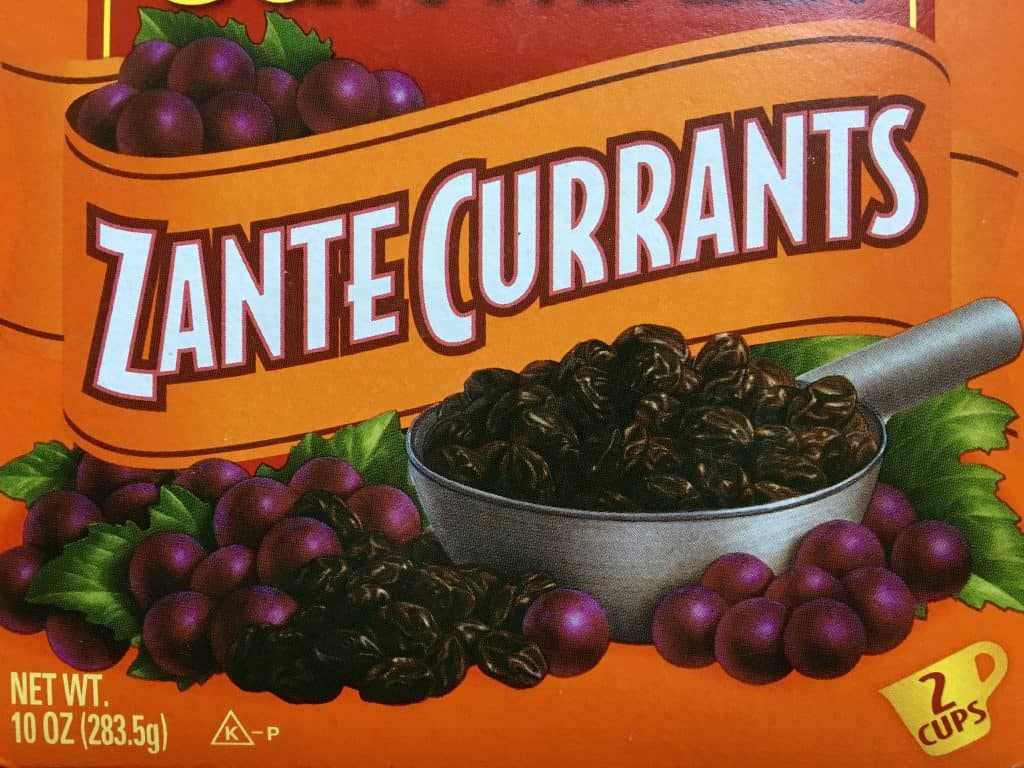
Herein lies the problem between distinguishing REAL black currants and with what some companies are calling “black currants”, but are selling dried grapes. You may not think it’s a big deal, but it really is–it’s called false advertising.
One very large company which sells on Amazon has been called out by so many customers, and given 1 star reviews because they are advertising and selling “black currants”, which are actually Zante currants. Despite these complaints for years, they refuse to change their labeling and Amazon has also not removed the product from its site.
The worst is that this company isn’t the only one doing this! (I won’t name names, but you can easily go to Amazon and search black currants; it’s probably the first thing you’ll see.)
What is also really terrible is that someone who has never had black currants (or possibly even Zante currants) before, will have no idea that they’ve been scammed. My mother and I were in a gourmet food warehouse once and came upon large bags of dried “black currants”! We were elated and bought a 2 lb bag each as we’d never seen them in a store before.
When we got home, I ripped open one of the bags and threw a handful in my mouth only to discover that they were Zante currants! Dried blackcurrants and dried Zante currants do look awfully similar as they are both dark and small. Although I like Zante currants, I cannot tell you how disappointed I was.
Health Benefits
Here’s another little known fact amongst US consumers: blackcurrants are a powerhouse of nutrition. The health benefits associated with these little purple berries are astounding. Here’s an example of how they stack up against other fruits~
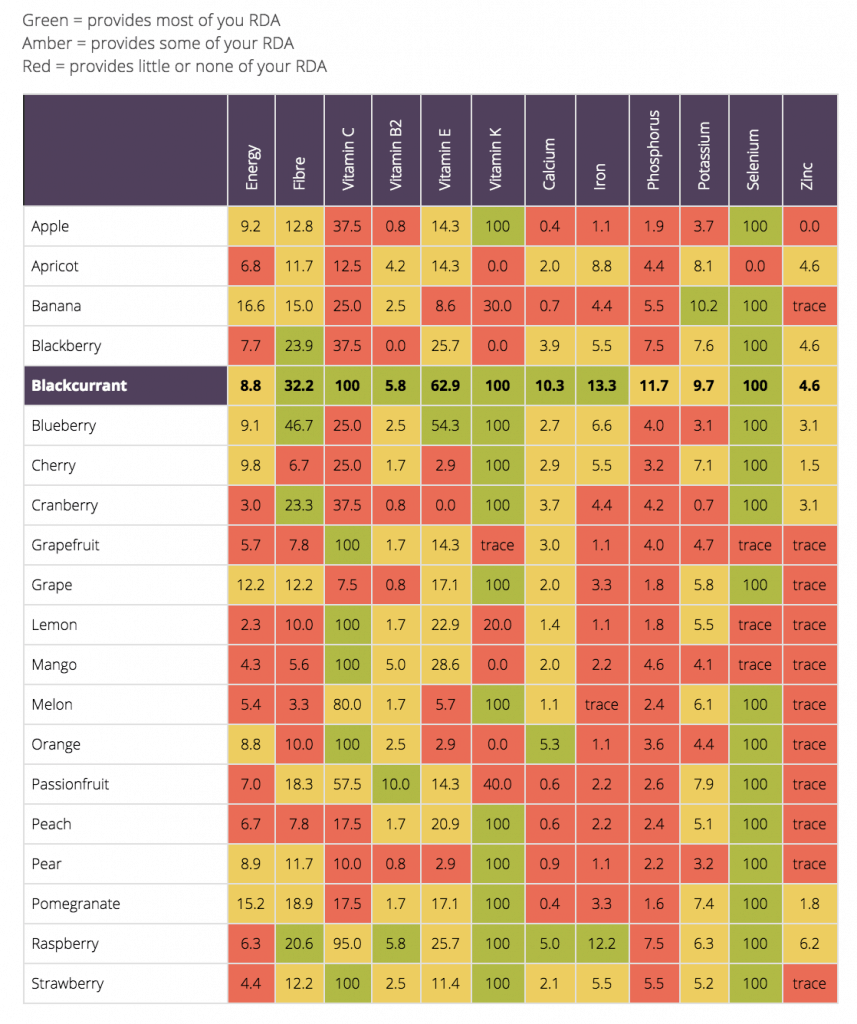
This chart doesn’t even touch on all the studies that have been done which suggest that blackcurrants offer benefits with vision, Alzheimer’s, cardiovascular health, aging and brain function, digestion, and even cancer! They have one of the highest levels of antioxidants that you can find in fruit.
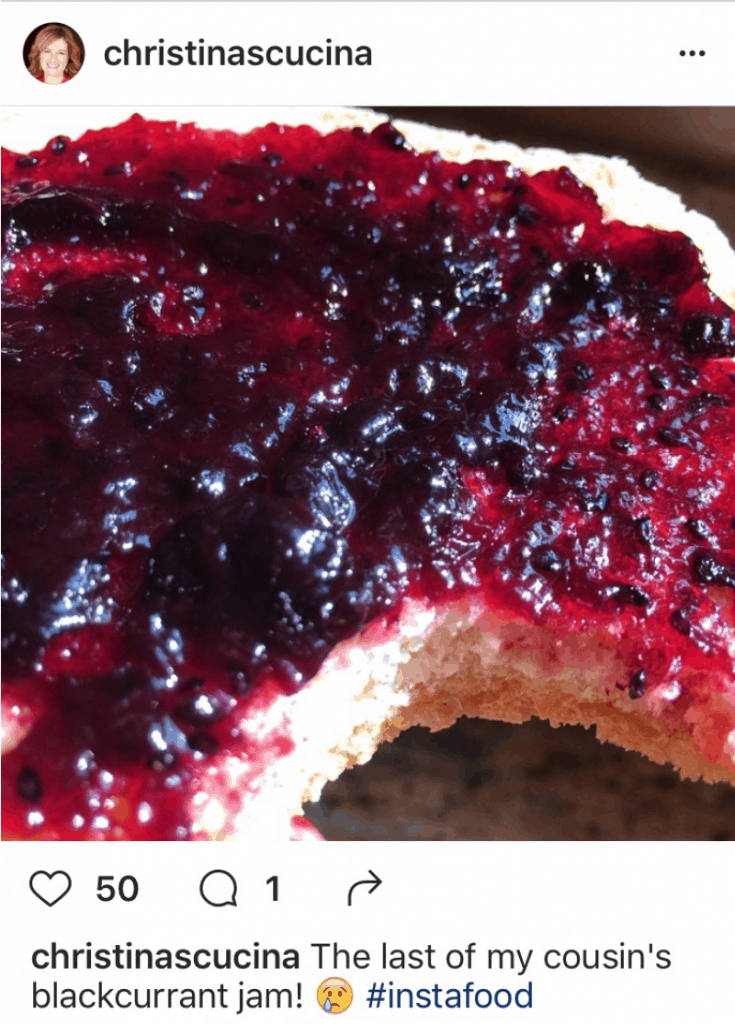
Let’s just say that I could write pages and pages, listing reasons why we should reintroduce black currants into our North American society, but what will really initiate change will be when we start asking for stores and companies to carry blackcurrant products, and we buy them. (We’ll start on red currants next, but I did buy some at a local market about a month ago! Yippee!)
Blackcurrant Uses and Recipes
Blackcurrants are sour little things, so most people don’t eat them fresh like raspberries or strawberries. Instead, they are often mixed with other fruits, or made into jam, compotes or syrups. Blackcurrants are wonderful when mixed with apples in a crumble or with other berries for all sorts of desserts. You can even make gelatin squares with the concentrate. They are also used in savory dishes, and as you’ve probably guessed, the possibilities are endless. Here are some recipes from a few of my blogger friends–just click on the photos for the recipes.
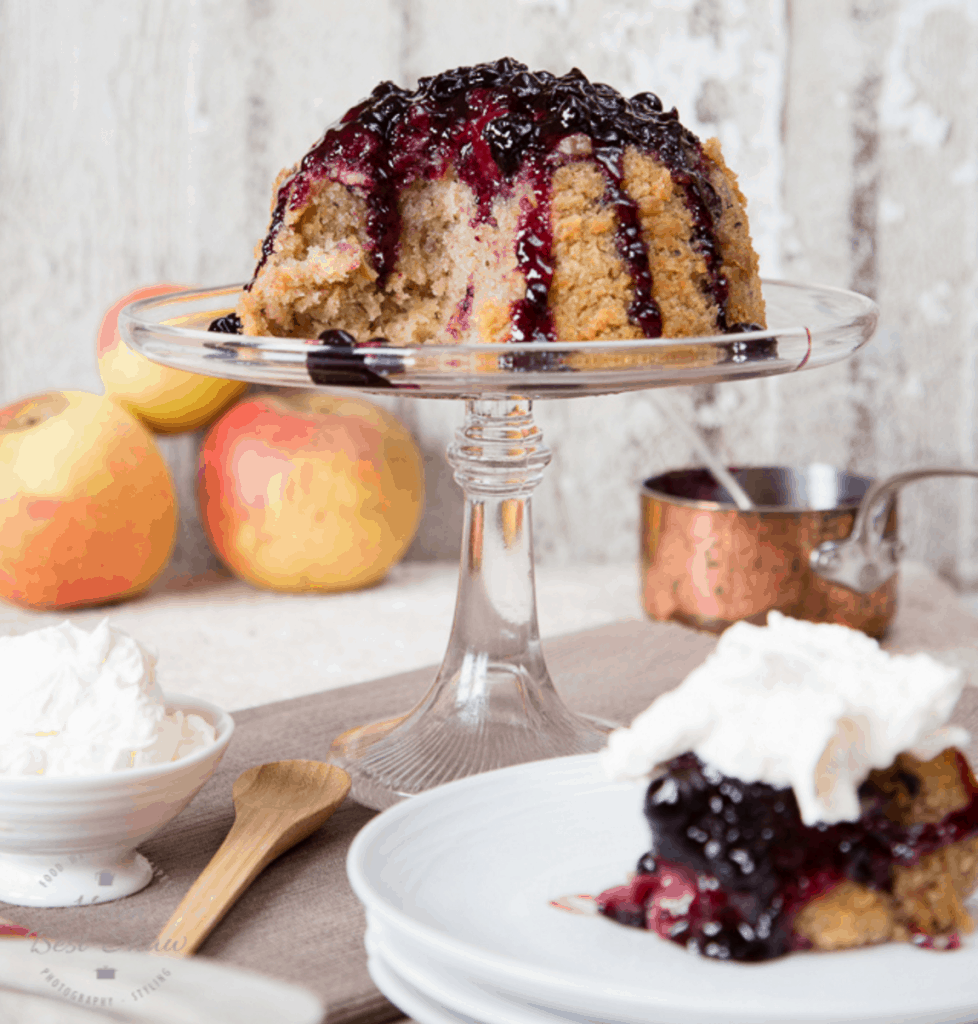
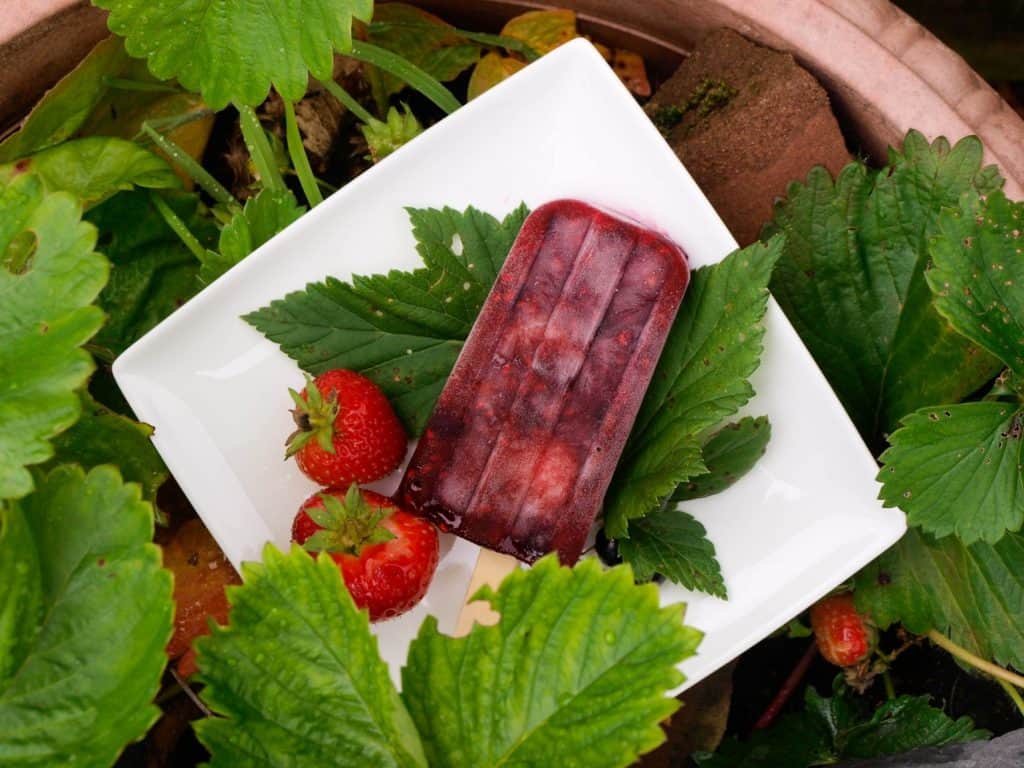

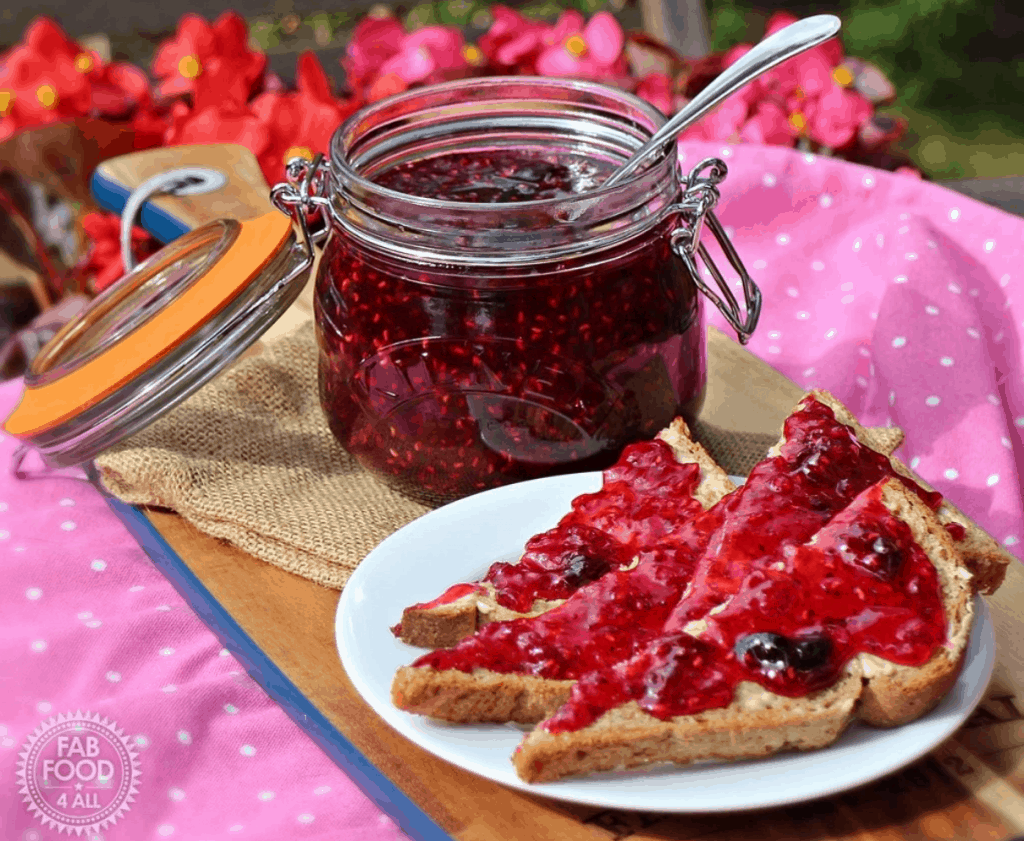
The first thing I made with my frozen blackcurrants was a batch of jam! I miss blackcurrant jam so much and being able to make it myself was fantastic as I can make it exactly how I like it. Blackcurrant jam is one of the easiest jams to make as it doesn’t need pectin, and sets really well on its own.
The measurements aren’t critical either, so feel free to add more sugar if you like your jam a bit on the sweeter side, or less if you really are into the tart flavor. This blackcurrant jam recipe is easy to tweak to your liking.
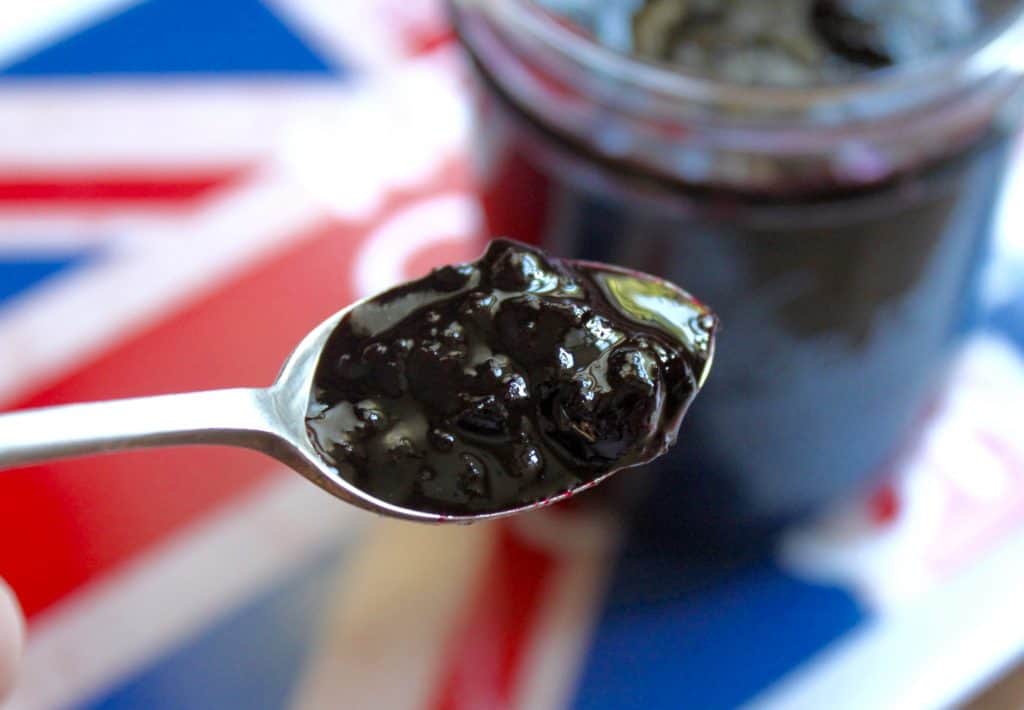
I miss blackcurrants and the flavor so much, the health benefits are secondary to me! I absolutely LOVE, LOVE, LOVE those beautiful purple currants! Maybe that’s why my favorite color is purple? That and the Cadbury’s packaging may have affected me for life! 💜
Blackcurrant Jam Recipe
adapted from a Mrs. Beeton recipe
Ingredients
- 2 lbs frozen black currants
- 20 oz (2 1/2 cups) water
- 2 lb sugar (about 2 1/2 cups)
- juice of one lemon
Place the black currants and water in a heavy pot over medium low heat. Cook the fruit for about half an hour or longer, stirring occasionally, to soften the skins.
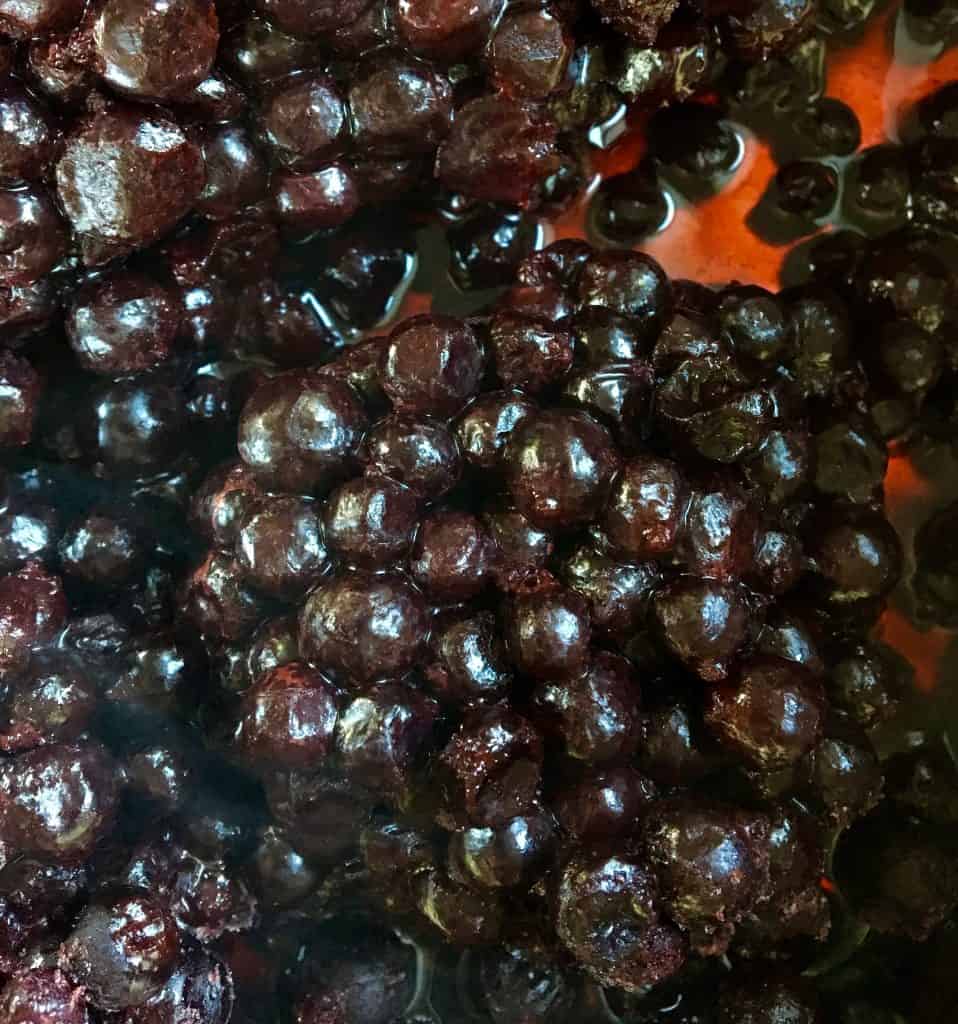
Add the sugar and lemon juice.
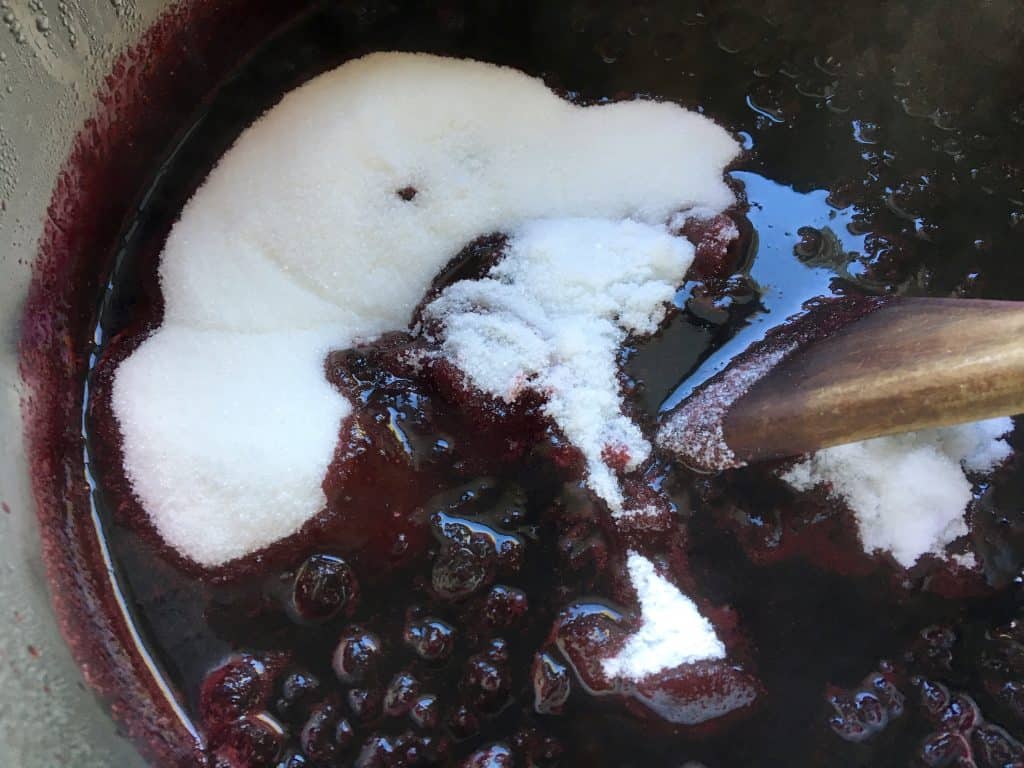
Increase the heat to simmer the jam briskly while constantly stirring. Use a candy thermometer to bring the temperature of the jam to 215°F (101.5°C) which should be reached in about 10 to 15 minutes.
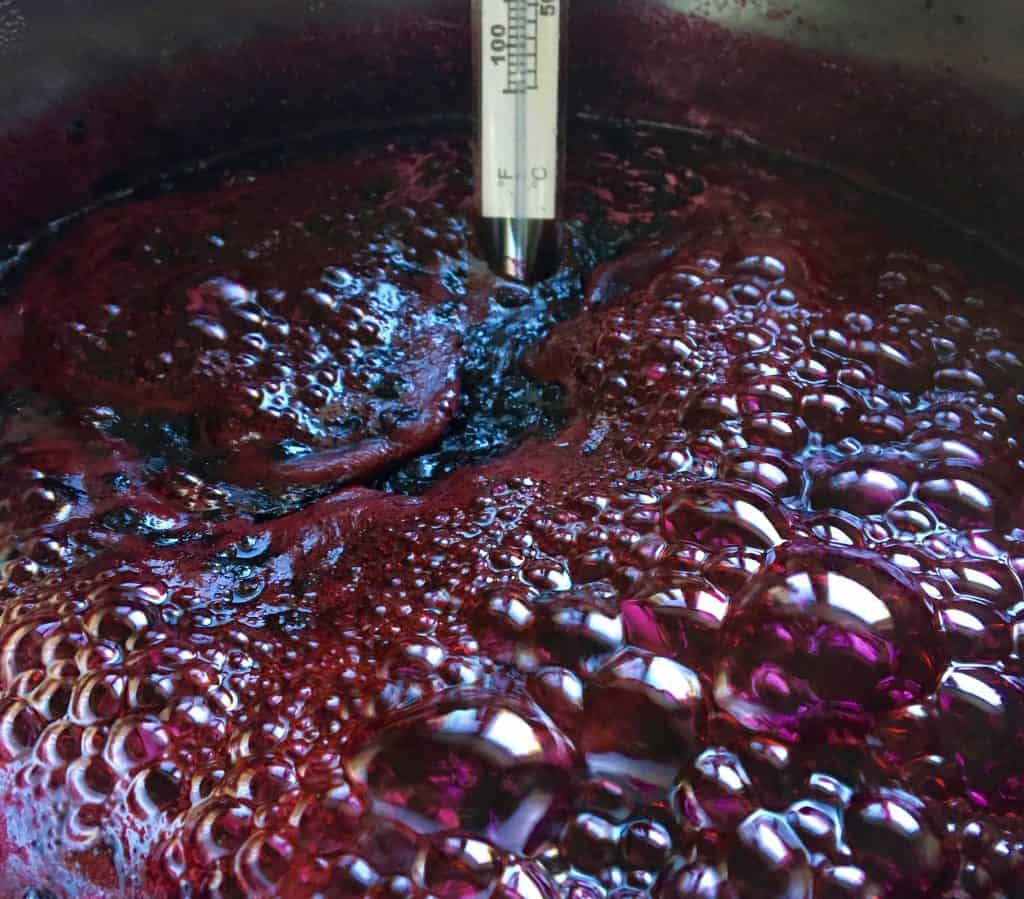
Pour into warm, dry jars which have been rinsed with boiling water, along with the lids.
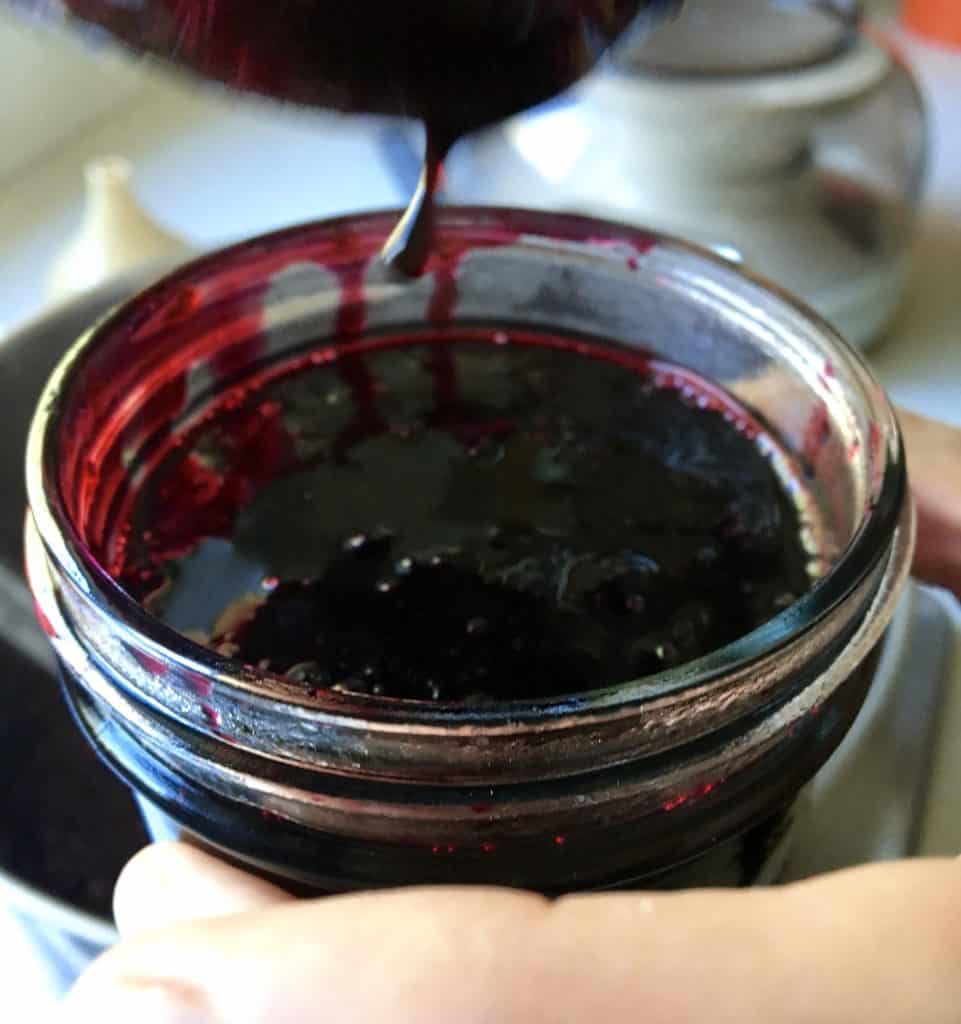
Process to seal, if desired, but you can just keep it in the fridge to be on the safe side. I make sure to hear/see my lids pop to ensure a seal.
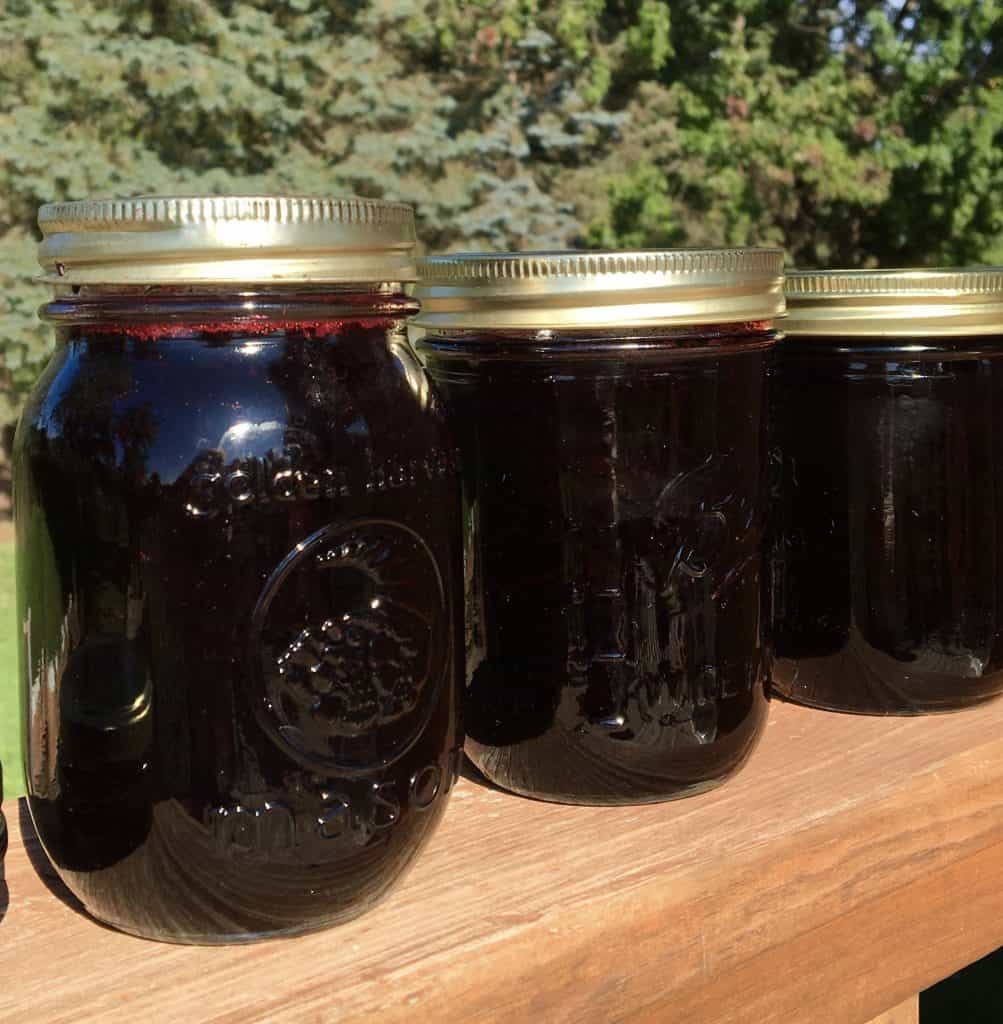
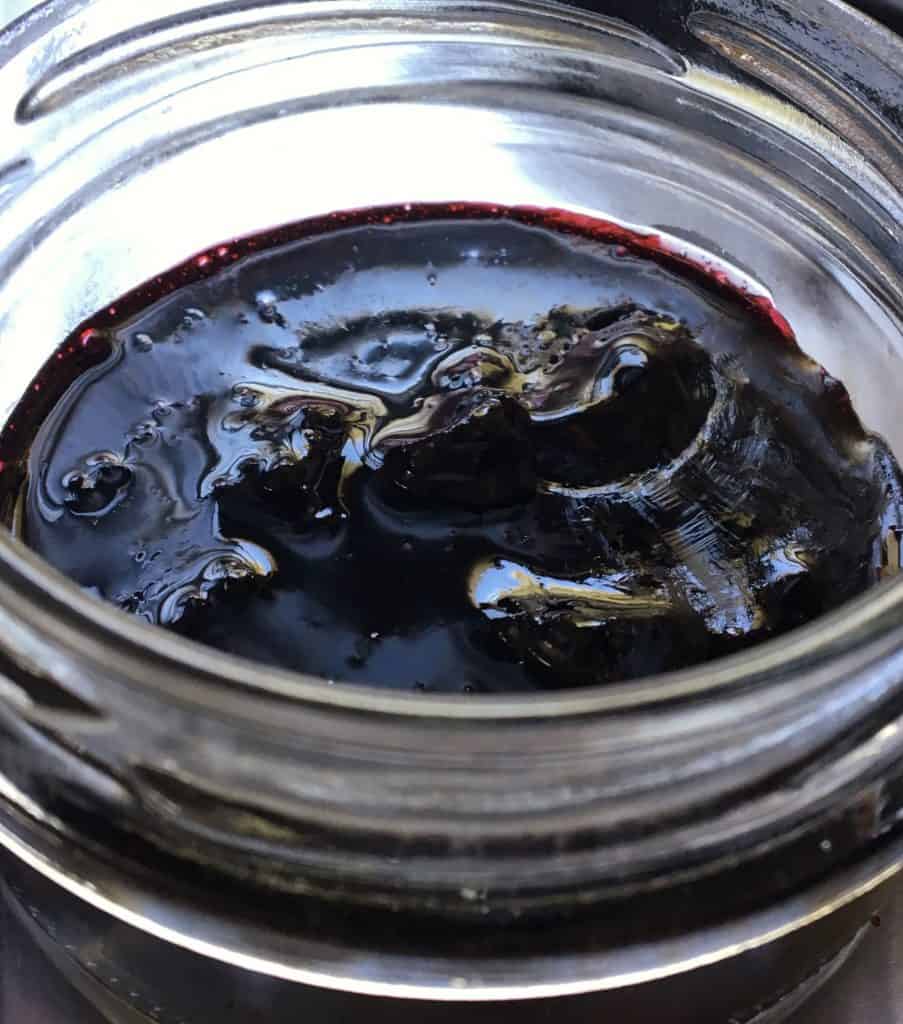
Don’t miss another recipe or travel post; sign up for my free subscription below!
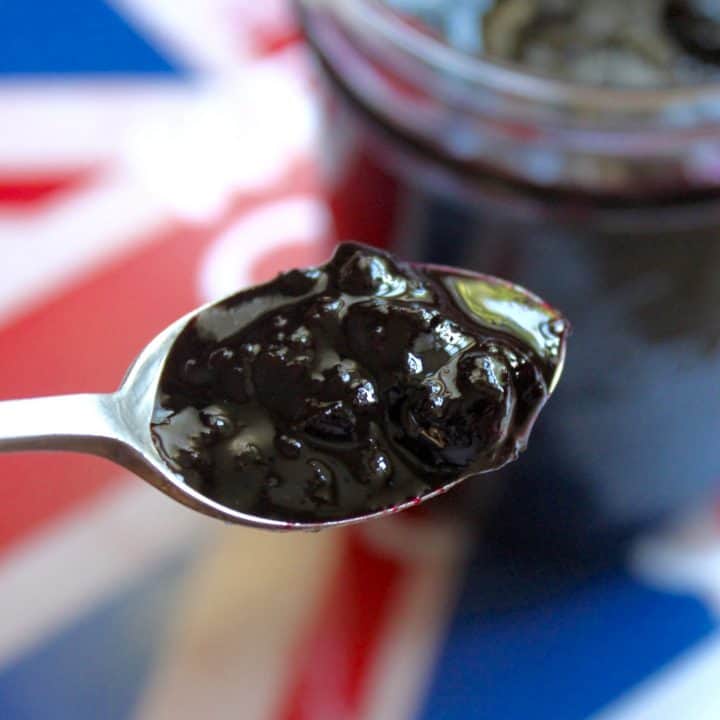
Blackcurrant Jam Recipe
A classic British jam made from blackcurrants (no pectin).
Ingredients
- 2 lbs frozen black currants
- 20 oz (2 1/2 cups) water
- 2 lb sugar (about 2 1/2 cups)
- juice of one lemon
Instructions
Place the black currants and water in a heavy pot over medium low heat. Cook the fruit for about half an hour or longer, stirring occasionally, to soften the skins.
Add the sugar and lemon juice.
Increase the heat to simmer the jam briskly while constantly stirring. Use a candy thermometer to bring the temperature of the jam to 215°F (101.5°C) which should be reached in about 10 to 15 minutes.
Pour into warm, dry jars which have been rinsed with boiling water, along with the lids.
Process to seal, if desired, but you can just keep it in the fridge to be on the safe side. I make sure to hear/see my lids pop to ensure a seal.
Nutrition Information:
Yield: 90 Serving Size: 1 tbspAmount Per Serving: Calories: 45Total Fat: 0gSaturated Fat: 0gTrans Fat: 0gUnsaturated Fat: 0gCholesterol: 0mgSodium: 0mgCarbohydrates: 12gFiber: 0gSugar: 10gProtein: 0g
Nutrition info is only estimated.

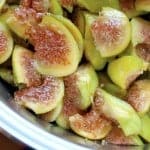
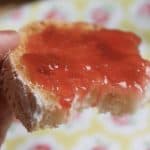
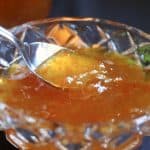
My late dad, here in the UK, used to grow blackcurrants in the garden. We never got around to making jam as my brothers and I ate them straight from the bush. When plump and ripe the acidity is balanced perfectly by sweetness but the fruit is quite delicate. I’ve never seen them dried or frozen but have bought commercially produced jam which is just too sweet.
Christina – my favourite fruit, too. I’m now inspired to take some cuttings from a friend’s bushes in a local allotment. Thanks.
Oh yes, that’s a fabulous idea if they grow where you live! I can’t grow them here in SoCal or I’d have bushes and bushes of them! Lucky you! Good luck with them!
Yesterday I picked 2 cups of wild black currents in southwestern Oregon USA. There’s a largest I’ve ever seen some Being over a centimeter! They are very sour, as I expected. But they are also quite bitter. Can I use them for anything or do I just have to throw them out?
Oh goodness no! Don’t throw them away! Blackcurrants are very sour! If you don’t want to make jam, there are many other recipes you can use them in. Did you see the other 4 recipes I linked to in this very post? Just scroll back up.
Thank you for the encouragement Christina I did try mixing about 10% black currant with 90% red Bartlett pears which are grown in the rogue Valley in Oregon where I live. I got a bunch that are some of the best I’ve ever eaten. I have a couple of people I know who don’t do sugar so I tried cooking the pears with the currents leaving the pears in spoon size pieces. I didn’t add any extra sugar at all and I think it tastes good. I was afraid they would be bitter but when it’s diluted it doesn’t taste bitter. So tonight I am back at it cleaning more currents. I got a bottle Of what I hope is a good flavored rum. I thought I could put about a teaspoon in to an 8 ounce jar as I cap each one. I did add a bit of pink Himalayan salt
What a lovely way to use them with the pears. Are you sure the currants will be okay with just one tsp of rum? I would cover them (and add some sugar) but that’s me :)
Wanted to stress that there is a red (and very sour!) type oF currant as well. But I can see that other people have posted comments about it. I myself prefer the black variety for most occasions. I am told that there is a white currant type too, but I have never tried those.
I have a few suggestions. You might know them, but I will post anyway:
* Creme de cassis, the French sweet sticky liqueur made from black currant is just delicious.
* Thick black currant jam drizzled over and lightly mixed in a glass of Greek yogurt is a dessert made in heaven! And something anybody can make.
* Vanilla ice creme with a splash of black currant concentrate. Just great.
* Black currant rum. Sounds weird? It’s a specialty made and sold in Denmark (of all places) for more than a hundred years, but you can try to make your own version if you like: Blend black currants with dark rum and add some muscovado sugar. Let it seep for a fortnight or more, then strain. You could add a few anis seeds and other herbs to experiment.
I know about white and red currants, and the other suggestions, except for the blackcurrant rum! Oh wow, that sounds wonderful! I think I might try that! Thank you!
Thank you for this discussion. I’m mostly familiar with black currants from the French creme de cassis, used in making the drink kir , and in a fabulous blueberry pie recipe I make. I lived for a brief time in London and it was the first time I had ever seen fresh currants, both black and red as well as gooseberries – both fruits I had only seen in pictures. What a treat! Also all sorts of other berries I had never heard of. Between that and the different varieties of cream, it got so that my husband finally asked if we could have something other than berries and cream for dessert!
Oh lucky you! I miss all those berries SO MUCH!
I live in Newfoundland Canada and we have always had Black Currants….my favourite for jam and muffins!
You don’t know how lucky you are, Audrey! Enjoy them!
Hi. I would like to share, that there is actually a red gooseberry type as well. It is a naturalized cross between black currant and ordinary gooseberry. Not that common, but they taste great :-)
Looks like all this fancy cooking is the art of making some healthy ingredients, unhealthy. Just get the blackcurrants and enjoy as they are, or freeze them for keeps. Subjecting fruit to temperatures above those of pasteurization destroys a proportion of their vitamins and phytonutrients
You are correct about the cooking of fruit, and let’s not get into the addition of sugar, however, in my opinion, your perspective is a bit skewed.
Must we eat everything in nature as is? That’s taking it a bit too far, I think. Go ahead and eat your black currants “as they are” (and good luck as they’re so sour), and I’ll eat mine in jam every now and then. I like to be a bit centered in life. Being off the scale in one way or another (eating raw with no added anything vs. totally processed) just isn’t my cup of tea.
Yes, enjoy as they are from the bush if you can. Some fruit can taste sour. most probably because we have become so used to piling on the sugar and therefore have warped our taste buds.
I have three varieties, Ben Alder, Ben Hope and Ben Lomond. I prefer the Ben Alder, very sour and tasty raw. Ben Hope are much sweeter, some will prefer them, but not so tasty in my view. I made jam yesterday using the same recipe minus the lemon. Beautiful. So easy to grow. And the birds are not eating them.
You can eat black currants raw, but I am willing to bet that you will not eat half a handful before your mouth revolts! :-D They are extremely astringent raw. even from are pure health perspective, consuming prepared or cooked black currants is desirable for several reasons.
First of all you will eat more of the berries that way, and maybe even on a regular basis. Perhaps this is most notable with black currant jams or juice concentrates. Secondly, eating the phytonutrients with other nutrients, including healthy fats, will increase their uptake. In the case of some berries – perhaps not black currants – cooking is needed to destroy phytotoxins, ie. natural chemicals that both makes you sick and hinders the uptake of the healthy substances.
Can you tell me where you get yours please. Looking to get some. How much per lb.
Here’s a place you can order from, Sharri: https://nwwildfoods.com/product/dried-black-currants/
Thank you so much for the information Christina. I’m English so I grew up with blackcurrants – in jam, pies, Ribena. My Mum grew her own blackcurrants so we always had lots of them … and I know how time-consuming they are to pick. My Mum made the best blackcurrant jam, absolutely loaded with fruit, and I really miss it. I just assumed I couldn’t buy blackcurrants here in the US as I’ve never seen them anywhere – thanks for the explanation on the history. I’ve bought jam online but it’s nothing like the homemade. I’ll give your recipe a try. Thank you!!
That’s great, Jackie! Let me know how it turns out, but I think you’ll be very happy with the results! :)
I purchased two Ben Connan Blackcurrant berry trees from a nursery and the taste is spectacular. Are these the same black currants you are referring to? They produced gobs of taste fruit. I was told they were supposed to taste bad. I also purchased two other currents from Walmart and the fruit form them tastes really bad to the point there is no way I will eat it. I took a handful of the Ben Connan Blackcurrant berries and threw them in one of my raised flower beds last fall. This spring as I was weeding I couldn’t figure out what kind of invasive tree was growing out of my flower bed. They turned out to be over 40 blackcurrants seedlings. I know they don’t produce until their third year but wonder if all these seedlings will produce tasty fruit. Anyways, I only have a 1/2 acre yard and am going to try to find a way to pant all of them. I removed all the seedlings and planted them in separate pots and placed them in my greenhouse. I was just excited to have free trees since I had to pay $25 for each of the blackcurrants form the nursery and wanted to share my excitement.
Oh my goodness, Chad! You are SOOOO lucky! YES! Black currants are so tasty, but sour, so maybe someone who told you they were bad was referring to the sour taste? I can’t imagine Walmart selling anything black currant. So glad that your seeds sprouted and you’ve been blessed with more seedlings! You’ll be able to dry them, bake and cook and make tons of jam! Lucky you!! Enjoy!
Hi Christiana,
I did not see how to start a new comment, so I am replying to this one even though my comments are unrelated to this specific post.
I take a minor issue with you calling your black currants the official use and specific to the plant grown in England.
The use of “currant” arose with the Greek variety, the Zante currant, with “currant” deriving from the city of Corinth where the variety was first cultivated.
So, your article implies the use of “currant” is somehow how the sole domain of the black currant grown in the UK, when, in reality, your variety is the usurper if it is not the Zante varietal.
Your comments may should have focused on the use of the adjective “black” vs. currant to claim exclusivity and the specificity you seek. You then can claim exclusivity to the specific variety but you cannot claim exclusivity based upon “currant”.
So, someone selling “black currants” online that are actually selling Zante currants are misleading the public because “black” currants are not the same as Zante currants.
In case I’m not expressing it clearly, it’s as if you are claiming the use of currants as a unique fruit separate from dried grapes, but it’s really the dried grapes from Greece (Corinth) that were first referred to as “currants”, known now as the Zante currants. Here is your statement that I have taken issue:
“Now, many of you may be familiar with Zante currants (or Corinthian raisins), which are essentially tiny raisins, right? They are called “currants”, but this is a misnomer as they are dried grapes!”
Dried grapes from Corinth are “currants”! If your fruit wants to be called currants, then it is this use that is a misnomer.
So, your agent should be for the usage of “black currants” to be the sole domain of those grown from the plant variety grown in UK. Then you could stop others from selling other types of currants as such. But you cannot claim exclusivity on the use of “currants”.
[…] drink recipe which includes a much too overlooked superfruit: black currants. I wrote about black currants last year, and how they hold a powerhouse of vitamins, and have so many health benefits, there are too many […]